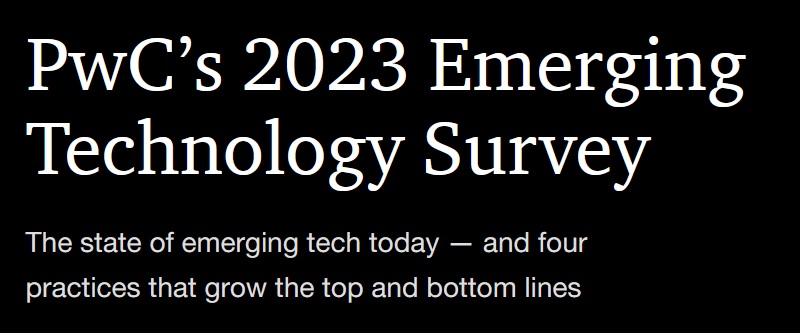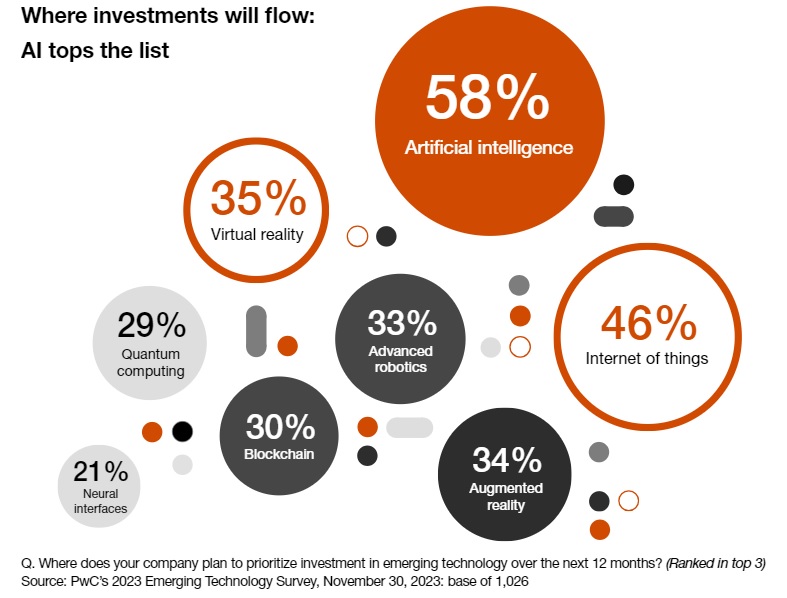With technology advancing at an unprecedented rate, it can be overwhelming for businesses to decide where to place their bets. From generative AI to blockchain, virtual reality to quantum computing — not to mention the convergence of these and other emerging technologies — the challenge is how to make the appropriate investments that align with an organization's needs and goals.
We designed our recent Emerging Technology Survey to help businesses navigate the evolving technology landscape. The results showed that while most corporate executives (89%) are increasing their technology budgets, only 7% are achieving value from their emerging technology investments. Executives in these organizations report significantly higher benefits from emerging tech in general, and from generative AI in particular, than their peers.

So how can you know whether your tech investments are prescient or premature?
And how can you pinpoint which technologies are right for your business now and which may be essential soon?
We call these 7% of respondents the EmTech Accelerators, who may hold the key to your success.
The "Essential Eight" Technologies Driving Business Transformation
PwC's "Essential Eight" is a curated list of technologies that PwC believes has the potential to create a significant impact across multiple industries and functions. We've organized the Essential Eight into three categories that reflect how business leaders can prioritize their efforts:
■ Essential to Expand: These technologies are integral to modern business operations and are now used at scale in many companies. AI and the Internet of Things (IoT) — from wearables and home appliances to enterprise-level connected devices — fall into this category, having demonstrated their broad applicability and value in streamlining routine processes, enhancing customer experiences, and driving business transformation.
■ Essential to Evaluate: This includes emerging technologies that may have been put on the backburner but now require re-evaluation given the pace of recent advancements. Blockchain systems for secure and transparent asset management; immersive experiences that blend the digital and physical worlds (Augmented Reality) or create entirely digital environments (Virtual Reality); and Advanced Robotics that autonomously interact and respond to the real-world are all on the cusp of more broad mainstream use.
■ Essential to Experiment: These more nascent technologies are rapidly advancing and have significant long-term potential, but they are still in the initial stages. Nevertheless, it's not too early to consider how your business or industry might benefit from implementing them. Quantum Computing, for example, is poised to revolutionize the way we work for its ability to help solve previously "unsolvable" problems and manage complex tasks in record time. Neuromorphic Computing, which mimics the architecture and functioning of the human brain, can create efficiencies in both data processing and power consumption for better sustainability and greater cost savings.
Where Technology Investment Dollars Are Going
AI is the clear investment leader, with 55% of companies having invested in AI (including generative AI) in the past year, citing it as their top priority. This trend should continue in 2024, as 58% of companies are expected to prioritize AI investments.
Alongside AI, companies will set their sights on other Essential Eight technologies as well:

IoT and Virtual Reality join AI in the top three, with 46% and 35% of respondents prioritizing investments in these technologies over the next 12 months. Blockchain investment was 30% overall, but rose to 46% in banking capital markets.
And we are seeing workforce roles reflect these investment trends, with 28% of respondents reporting that at least one-fifth of their employees engage in emerging tech as part of their job function
But while the focus on tech investment is universal, the EmTech Accelerators are doing it differently — and with greater results.
Meet the EmTech Accelerators: Top Performers Unlocking Consistent Value
We designed two indexes to identify how much measurable value companies have already achieved from tech-related investments. One index covered all Essential Eight technologies and the other focused on GenAI specifically. EmTech Accelerators reached the top 10% across both indexes.
Unlike other companies, EmTech Accelerators use technology primarily to drive growth-related activities. They significantly outperform the overall sample in improved products and services, faster time to market, better decision-making, and higher profits.
As we took a closer look at what makes the EmTech Accelerators so successful, we found some common leading practices that these companies employ to increase their investments and outperform their peers:
■ Use emerging technology for reinvention: EmTech Accelerators often look outside their industry for use cases to adopt. They then quickly adapt these use cases to create new experiences for customers and employees — or develop entirely new growth strategies for specific lines of business.
■ Allocate the right resources: EmTech Accelerators invest more financial and human capital in emerging technologies. They prioritize flexibility and collaboration, as well as upskilling employees to build organizational trust in new tech.
■ Integrate emerging technology: More than four-fifths of EmTech Accelerators understand that convergence is king. The more these technologies work together — AI to analyze IoT data, quantum computing to enhance virtual spaces — the more data you can gather and use for better decision making and greater ROI.
■ Embed emerging tech into your business strategy: Close collaboration between business and technology leaders helps organizations create value and confirm that the Essential Eight are deployed responsibly. The appropriate governance, standards and accountability go a long way toward driving innovation and building trust.
Outside of the EmTech Accelerators, very few organizations in 2023 were getting the most out of their emerging technology investments. As we enter 2024, companies should follow the practices of EmTech Accelerators and implement emerging tech into their long-term strategies and operations. Only then can they increase the return on their tech investments and drive sustained innovation.
